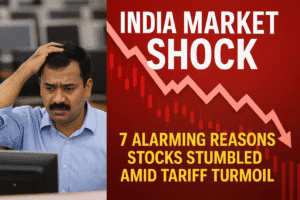India Market Shock: 7 Alarming Reasons Stocks Stumbled Amid Tariff Turmoil
On July 14, 2025, the Indian stock market opened on a cautious note amid global tariff fears and persistent foreign investor outflows. Investor sentiment was rattled by former US President Trump’s announcement of steep tariffs on the EU and Mexico, sparking speculation that India could face similar treatment, especially with rumors of a potential 500% tariff. This uncertainty weighed heavily on export-driven sectors, particularly IT.
Foreign Institutional Investors intensified the pressure, pulling out over ₹10,000 crore in July so far, while domestic institutions provided partial relief with strong buying. TCS disappointed despite a profit beat, as revenue declined and broader tech sector fears deepened. The rupee weakened amid global risk aversion, while commodities like gold and oil gained investor attention. Notable corporate moves included Smartworks’ IPO success and Ola Electric’s widening losses. Overall, the day reflected risk-off sentiment, with investors wary of geopolitical shocks and awaiting key domestic cues.

India Market Shock: 7 Alarming Reasons Stocks Stumbled Amid Tariff Turmoil
The Indian stock market opened the week under a cloud of global uncertainty and sector-specific pressures on July 14, 2025. While indices saw only modest initial declines, the underlying currents revealed deeper investor anxieties. Here’s a breakdown of the key drivers and what they meant for investors:
- The Looming Shadow of US Tariffs:
- The Trigger: Fresh fears erupted after former US President Donald Trump’s announcement of steep new tariffs (30%) on the EU and Mexico, effective August 1st. This reignited concerns that India could be next.
- Market Fear: Prashanth Tapse (Mehta Equities) crystallized the worry: markets were “edgy” amid speculation of potential 500% tariffs on Indian goods. While an interim deal might cap them below 20%, the sheer uncertainty weighed heavily.
- Impact: This geopolitical risk directly contributed to the cautious opening and sustained pressure, particularly on export-oriented sectors.
- FII Exodus Continues Unabated:
- The Data: Foreign Institutional Investors (FIIs) were relentless sellers. On July 11th alone, they offloaded ₹5,104 crore. The cumulative outflow for July hit a significant ₹10,062 crore.
- The Pressure: This sustained selling creates a major overhang on large-cap indices like the Sensex and Nifty, countering domestic support and limiting upside potential. It reflects global risk aversion and specific concerns about India’s near-term prospects.
- Tech Stocks: The Weakest Link:
- Sectoral Drag: Technology stocks, heavily reliant on global (especially US) demand, bore the brunt of the tariff fears. They were a primary factor cited for the market’s weak opening.
- TCS Disappointment: Adding fuel to the fire, TCS shares fell 1.44% despite a profit beat. A 1.6% QoQ revenue decline missed estimates, highlighting persistent challenges in the sector and dampening sentiment further.
- Domestic Institutions: The Silver Lining:
- Counterbalance: Providing some stability, Domestic Institutional Investors (DIIs) invested ₹3,558 crore on July 11th. Their continued buying helps absorb FII selling and prevents deeper declines, showcasing domestic confidence.
- Rupee Feels the Heat:
- Double Whammy: The combination of FII outflows and heightened global risk aversion (driven by tariff fears) pushed the rupee down 17 paise against the dollar to 85.97 in early trade. A stronger dollar globally exacerbated the pressure.
- Commodities: Safe Havens & Speculation:
- Gold’s Appeal: Aksha Kamboj (India Bullion) noted gold approaching $3,400/oz globally as investors sought safety amidst the renewed trade tensions. However, a strong dollar was seen potentially capping further sharp gains in the near term.
- Crude’s Wait-and-See: Oil prices edged higher as traders awaited a promised “major announcement” by Trump regarding Russia. Any disruption to Russian supplies could significantly impact global oil flows and prices.
- Natural Gas Caution: Analysts warned of a potential corrective bounce in Natural Gas (MCX) after a steep fall, advising against fresh short positions until a clear breakdown below ₹270/mmBtu occurred.
- Key Stock-Specific Moves:
- Smartworks IPO Success: In a bright spot, the Smartworks Coworking Spaces IPO was oversubscribed 1.9 times on its final day, showing strong investor appetite for the segment, particularly from retail investors.
- Ola Electric’s Struggle: Ola reported a widened net loss of ₹428 crore in Q1 FY26, with revenue down to ₹828 crore. The path to profitability remained challenging.
- Corporate Actions: VIP Industries fell 4.3% as promoters agreed to sell up to 32% stake. BEML rose 1.7% on plans to consider a stock split. Wockhardt gained 1.6% on US operations realignment. HG Infra dropped 1.6% after approving ₹400 crore NCD issuance.
The Bottom Line for Investors:
July 14th wasn’t about a market crash, but about heightened caution and risk aversion. The primary culprits were external:
- Geopolitical Sword of Damocles: The specter of disruptive US tariffs on India created palpable uncertainty, directly impacting FII sentiment and export-focused sectors like IT.
- Relentless FII Selling: The significant capital outflow was a major structural headwind for the market.
- Tech Sector Woes: TCS’s revenue miss amplified existing sectoral concerns.
While domestic institutions provided support and select stocks/IPOs showed strength, the overall tone was defensive. Investors were clearly bracing for potential volatility stemming from US policy announcements and awaiting key domestic triggers like inflation data and more corporate earnings. The market’s resilience would be tested by how these external risks, particularly the tariff threat, evolved in the coming days and weeks.
You must be logged in to post a comment.